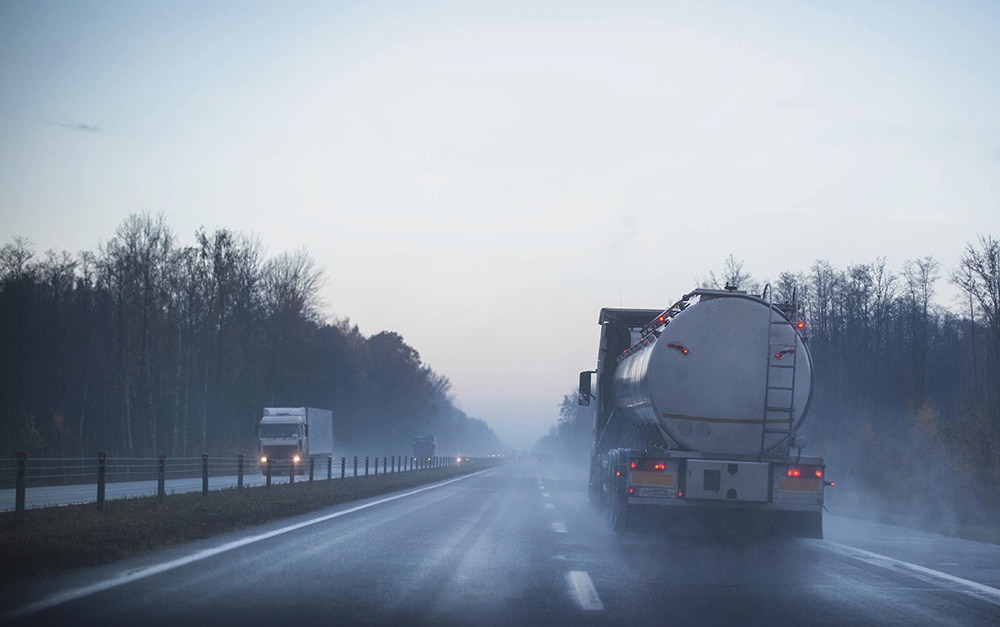How Much Slower Should Trucks Travel in Poor Conditions?

Whether you drive a box truck, like those available for rent at U-Haul or Penske, or an 80,000 pound 18-wheeler, there will invariably come a time when you will find yourself driving in inclement weather. While you might want to keep your foot heavy on the gas pedal in such weather conditions to minimize the chances of reaching your destination late, doing so is ill-advised.
Multiple studies show precisely why that is the case, one of which comes from the National Highway Traffic Safety Administration (NHTSA). According to data compiled by the government agency, wet roads and careless driving contribute to some 70% of weather-related vehicle accidents. But the reality of what happens on American roadways in poor weather conditions does not end there.
The same NHTSA study revealed weather-related accidents account for some 6,000 deaths and an even more staggering 445,000 injuries each year in the U.S. In the trucking industry, specifically, an estimated 23% of large-truck crashes happen because commercial motor vehicle (CMV) drivers are traveling too fast in poor weather conditions, according to a separate study from the Federal Motor Carrier Safety Administration. Of course, these numbers could be drastically lower if all drivers, commercial or otherwise, were to slow down when weather conditions suddenly or gradually take a turn for the worst.
Poor Weather Conditions Comprises More than Wet Roads
According to the National Highway Traffic Safety Administration, rain is a factor in about 46% of the 70% of the weather-related vehicle accidents that happen each year in the U.S., and it’s not difficult to see why that would be the case. After all, poor visibility and slick roads don’t make for the best driving conditions. Throw in high driving speeds, and things can quickly go from bad to worse. Along with wet roads and rain, the U.S. Department of Transportation (DOT) defines the following as poor weather conditions in which drivers should travel at a speed that is considered reasonable and safe:
- Snowy roads
- Sleet
- Icy roads
- Heavy fog
The NHTSA further notes that uneven roads, construction zones, curves, intersections, gravel roads, and heavy traffic are also reasons for commercial and everyday drivers to slow down, especially if poor weather conditions become part of the equation.
How Much Slower Should You Drive in Poor Weather Conditions?
While most would agree that slowing down when driving in poor weather conditions is a good thing, most can also appreciate being somewhere when you need to be there. And this is especially true for commercial drivers who fully believe that time is money. That said, drivers should reduce their driving speed by at least a 1/3 when driving on wet roads, according to the DOT. The government agent further notes that drivers should reduce their driving speed by 1/2 or more when driving on snow-packed roads.
It should be made clear that these reductions are based on posted speed limits. Drivers should avoid exceeding the speed limit even in optimal weather conditions since failing to do so can cause just as many accidents as driving in poor weather conditions.
The Real Cost of Poor Weather Conditions
Poor weather conditions alone are enough to make any journey more difficult, but most drivers say having to drive slower because of them adds a financial aspect to the equation. So what are they talking about, exactly? The answer lies in an aphorism that most of us can identify with, time is money. According to an article published by Zipline Logistics, a third-party logistics provider in Ohio specializing in managed transportation services and complete network outsourcing, drivers lose money whenever they have to drop off a load late because of poor weather conditions. They also lose money when those poor weather conditions keep them from reaching a warehouse or a similar facility for pickup. To further put this into perspective, let’s look at what the DOT has to say on the matter.
In a 2018 study, DOT researchers revealed that professional, commercial truck drivers lose roughly $1 billion to a little over $1.3 billion in take-home pay annually due to detention time. For those not in the trucking industry or those just not familiar with detention time, it is any amount of time exceeding two hours that a truck spends waiting to be loaded or unloaded and finally put back out on the road. Of course, none of this justifies driving too fast or too recklessly in less than ideal weather conditions, but it does help clarify why so many drivers take that risk.
Although there is a time and financial cost that can stem from having to drive at a slower speed in poor weather conditions, it is still worth doing. An accident is never worth the risk. If you have had the misfortune of being involved in an accident that was caused by a trucker driving recklessly, you deserve full compensation and justice. Get in touch with Schweickert Ganassin Krzak Rundio, LLP to learn how you can potentially take legal action.










